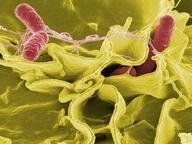Quiz Answer Key and Fun Facts
1. Up to 40% of the general population carries this organism in their nose; it is known to cause toxic shock syndrome (TSS).
2. This pathogen, able to grow in Todd-Hewitt broth, is known to cause the characteristic "strawberry tongue" disease, scarlet fever.
3. These Gram negative, kidney-bean shaped cocci are the reason silver nitrate was traditionally administered to the eyes of newborns.
4. The DTaP vaccine is a prevention mechanism for this pathogen, which is transmitted via aerosol droplets and leads to pseudomembrane formation in the throat.
5. What does MRSA stand for?
6. Polymerase chain reaction (PCR), a common detection method in the clinical laboratory, uses all of the folling processes EXCEPT one. Which process in not involved in PCR?
7. Which of the following oranisms is the SMALLEST free-living organism, at the miniscule size of 0.12 to 0.25 micrometers?
8. This organism is responsible for causing chlamydia of the urogenital tract.
9. Listeria monocytogenes is an organism responsible for such diseases as gastroenteritis, meningitis, and septicemia in pregnant women and fetuses/newborns. Which of these characteristics does NOT apply to Listeria monocytogenes?
10. Ersyipelothrix rhusiopathiae causes characteristic diamond-shaped erysipeloid lesions on the skin and can be indentified clincally through the use of triple sugar iron (TSI) slants. When recording slant results, what does K/A mean in terms of sugars fermented?
Source: Author
volleybuff33
This quiz was reviewed by FunTrivia editor
crisw before going online.
Any errors found in FunTrivia content are routinely corrected through our feedback system.
